Environmental Issues Teaching Plan for 8th-10th Grade Students
VerifiedAdded on 2022/11/30
|12
|2247
|202
Project
AI Summary
This project presents a community teaching work plan proposal focusing on environmental issues, specifically targeting 8th-10th grade students. The plan includes a comprehensive overview of the topic, emphasizing the importance of environmental protection and the negative impacts of human activities. It incorporates epidemiological data and statistics to highlight the severity of the issues such as waste disposal, pollution, and deforestation. The teaching plan outlines the nursing diagnosis, readiness for learning, and the application of the teach-back method to assess understanding. The project aligns with Healthy People 2020 objectives, specifically addressing the reduction of pollution and promotion of alternative transportation. It details behavioral objectives across cognitive, affective, and psychomotor domains, along with corresponding teaching strategies like PowerPoint presentations, demonstration videos, and role-playing. The plan also incorporates creativity in teaching methods, planned evaluations of objectives and goals, and addresses potential barriers. The presentation will begin by introducing the topic and showing the ways by which we are creating an impact on our environment. The students will be asked to participate in active listening games based on environmental issues. The plan concludes with nonverbal communication techniques and relevant references.
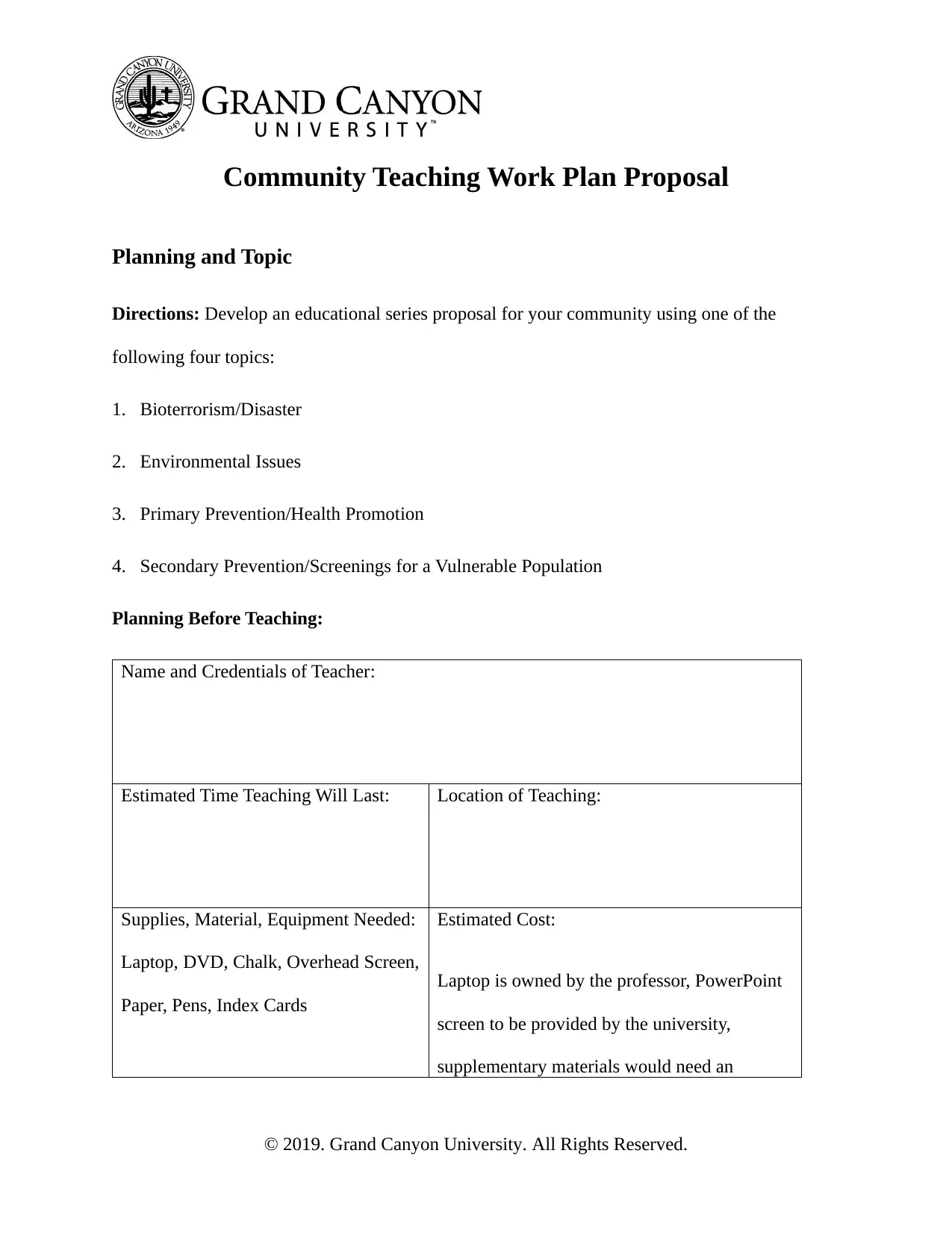
Community Teaching Work Plan Proposal
Planning and Topic
Directions: Develop an educational series proposal for your community using one of the
following four topics:
1. Bioterrorism/Disaster
2. Environmental Issues
3. Primary Prevention/Health Promotion
4. Secondary Prevention/Screenings for a Vulnerable Population
Planning Before Teaching:
Name and Credentials of Teacher:
Estimated Time Teaching Will Last: Location of Teaching:
Supplies, Material, Equipment Needed:
Laptop, DVD, Chalk, Overhead Screen,
Paper, Pens, Index Cards
Estimated Cost:
Laptop is owned by the professor, PowerPoint
screen to be provided by the university,
supplementary materials would need an
© 2019. Grand Canyon University. All Rights Reserved.
Planning and Topic
Directions: Develop an educational series proposal for your community using one of the
following four topics:
1. Bioterrorism/Disaster
2. Environmental Issues
3. Primary Prevention/Health Promotion
4. Secondary Prevention/Screenings for a Vulnerable Population
Planning Before Teaching:
Name and Credentials of Teacher:
Estimated Time Teaching Will Last: Location of Teaching:
Supplies, Material, Equipment Needed:
Laptop, DVD, Chalk, Overhead Screen,
Paper, Pens, Index Cards
Estimated Cost:
Laptop is owned by the professor, PowerPoint
screen to be provided by the university,
supplementary materials would need an
© 2019. Grand Canyon University. All Rights Reserved.
Paraphrase This Document
Need a fresh take? Get an instant paraphrase of this document with our AI Paraphraser
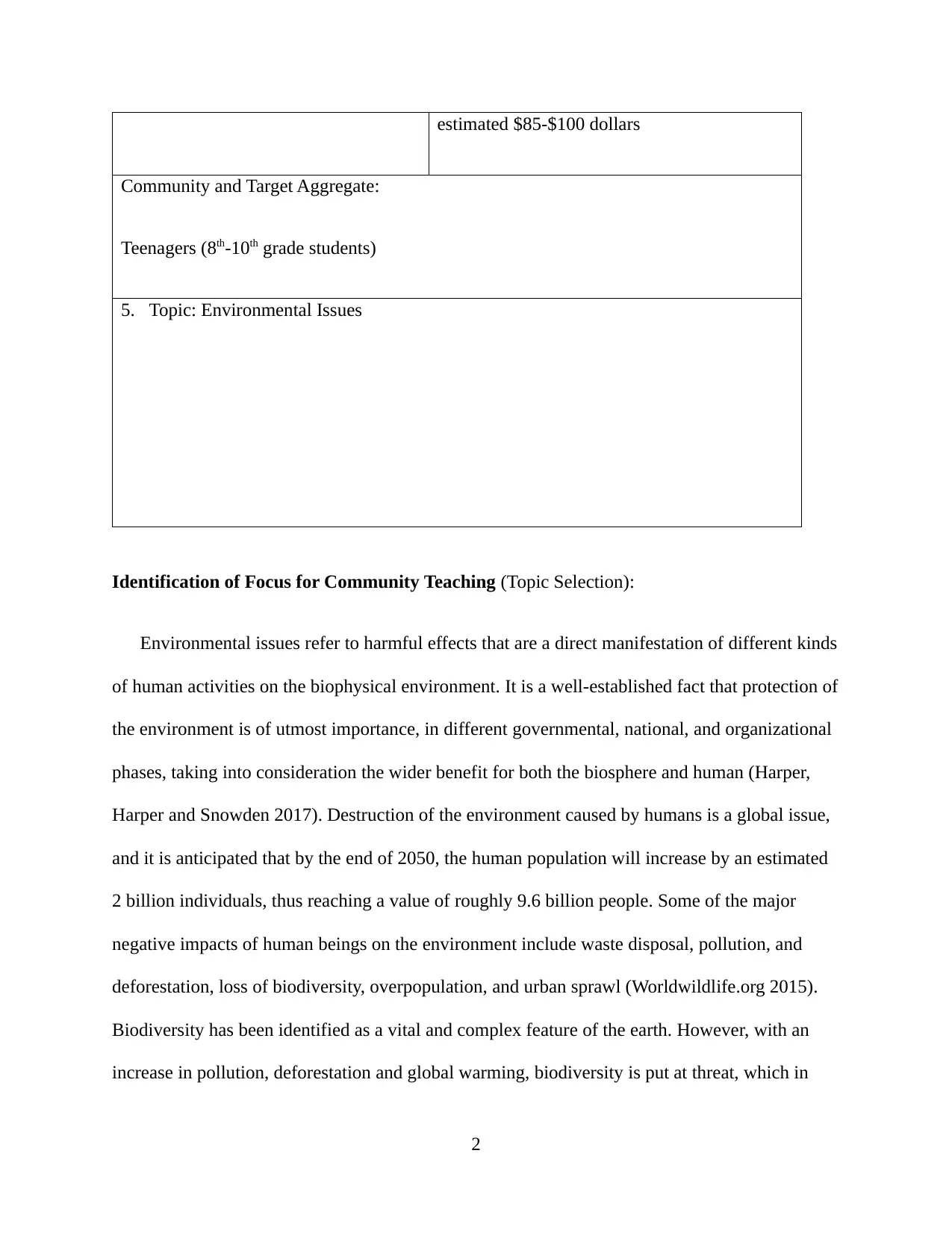
estimated $85-$100 dollars
Community and Target Aggregate:
Teenagers (8th-10th grade students)
5. Topic: Environmental Issues
Identification of Focus for Community Teaching (Topic Selection):
Environmental issues refer to harmful effects that are a direct manifestation of different kinds
of human activities on the biophysical environment. It is a well-established fact that protection of
the environment is of utmost importance, in different governmental, national, and organizational
phases, taking into consideration the wider benefit for both the biosphere and human (Harper,
Harper and Snowden 2017). Destruction of the environment caused by humans is a global issue,
and it is anticipated that by the end of 2050, the human population will increase by an estimated
2 billion individuals, thus reaching a value of roughly 9.6 billion people. Some of the major
negative impacts of human beings on the environment include waste disposal, pollution, and
deforestation, loss of biodiversity, overpopulation, and urban sprawl (Worldwildlife.org 2015).
Biodiversity has been identified as a vital and complex feature of the earth. However, with an
increase in pollution, deforestation and global warming, biodiversity is put at threat, which in
2
Community and Target Aggregate:
Teenagers (8th-10th grade students)
5. Topic: Environmental Issues
Identification of Focus for Community Teaching (Topic Selection):
Environmental issues refer to harmful effects that are a direct manifestation of different kinds
of human activities on the biophysical environment. It is a well-established fact that protection of
the environment is of utmost importance, in different governmental, national, and organizational
phases, taking into consideration the wider benefit for both the biosphere and human (Harper,
Harper and Snowden 2017). Destruction of the environment caused by humans is a global issue,
and it is anticipated that by the end of 2050, the human population will increase by an estimated
2 billion individuals, thus reaching a value of roughly 9.6 billion people. Some of the major
negative impacts of human beings on the environment include waste disposal, pollution, and
deforestation, loss of biodiversity, overpopulation, and urban sprawl (Worldwildlife.org 2015).
Biodiversity has been identified as a vital and complex feature of the earth. However, with an
increase in pollution, deforestation and global warming, biodiversity is put at threat, which in
2
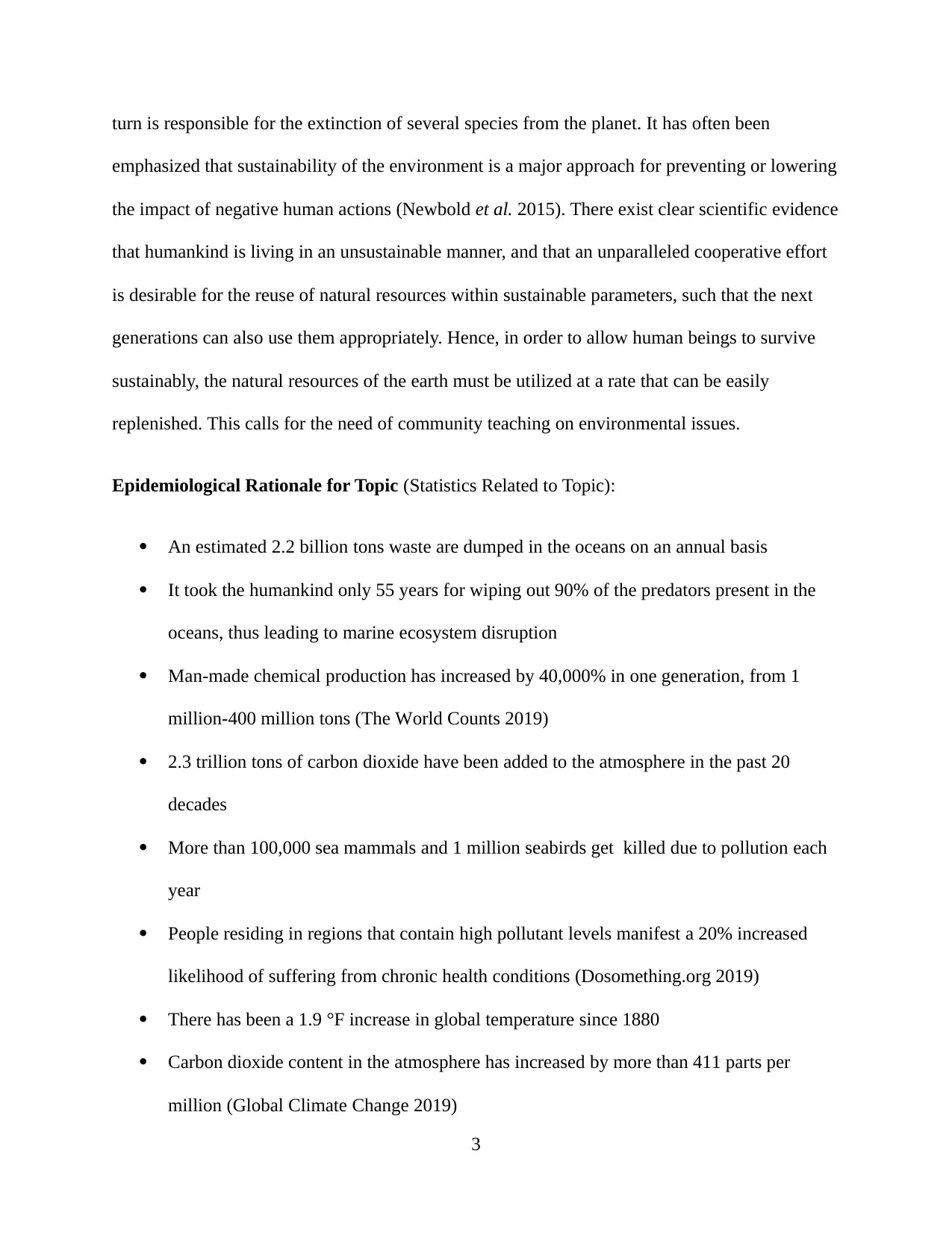
turn is responsible for the extinction of several species from the planet. It has often been
emphasized that sustainability of the environment is a major approach for preventing or lowering
the impact of negative human actions (Newbold et al. 2015). There exist clear scientific evidence
that humankind is living in an unsustainable manner, and that an unparalleled cooperative effort
is desirable for the reuse of natural resources within sustainable parameters, such that the next
generations can also use them appropriately. Hence, in order to allow human beings to survive
sustainably, the natural resources of the earth must be utilized at a rate that can be easily
replenished. This calls for the need of community teaching on environmental issues.
Epidemiological Rationale for Topic (Statistics Related to Topic):
An estimated 2.2 billion tons waste are dumped in the oceans on an annual basis
It took the humankind only 55 years for wiping out 90% of the predators present in the
oceans, thus leading to marine ecosystem disruption
Man-made chemical production has increased by 40,000% in one generation, from 1
million-400 million tons (The World Counts 2019)
2.3 trillion tons of carbon dioxide have been added to the atmosphere in the past 20
decades
More than 100,000 sea mammals and 1 million seabirds get killed due to pollution each
year
People residing in regions that contain high pollutant levels manifest a 20% increased
likelihood of suffering from chronic health conditions (Dosomething.org 2019)
There has been a 1.9 °F increase in global temperature since 1880
Carbon dioxide content in the atmosphere has increased by more than 411 parts per
million (Global Climate Change 2019)
3
emphasized that sustainability of the environment is a major approach for preventing or lowering
the impact of negative human actions (Newbold et al. 2015). There exist clear scientific evidence
that humankind is living in an unsustainable manner, and that an unparalleled cooperative effort
is desirable for the reuse of natural resources within sustainable parameters, such that the next
generations can also use them appropriately. Hence, in order to allow human beings to survive
sustainably, the natural resources of the earth must be utilized at a rate that can be easily
replenished. This calls for the need of community teaching on environmental issues.
Epidemiological Rationale for Topic (Statistics Related to Topic):
An estimated 2.2 billion tons waste are dumped in the oceans on an annual basis
It took the humankind only 55 years for wiping out 90% of the predators present in the
oceans, thus leading to marine ecosystem disruption
Man-made chemical production has increased by 40,000% in one generation, from 1
million-400 million tons (The World Counts 2019)
2.3 trillion tons of carbon dioxide have been added to the atmosphere in the past 20
decades
More than 100,000 sea mammals and 1 million seabirds get killed due to pollution each
year
People residing in regions that contain high pollutant levels manifest a 20% increased
likelihood of suffering from chronic health conditions (Dosomething.org 2019)
There has been a 1.9 °F increase in global temperature since 1880
Carbon dioxide content in the atmosphere has increased by more than 411 parts per
million (Global Climate Change 2019)
3
⊘ This is a preview!⊘
Do you want full access?
Subscribe today to unlock all pages.

Trusted by 1+ million students worldwide
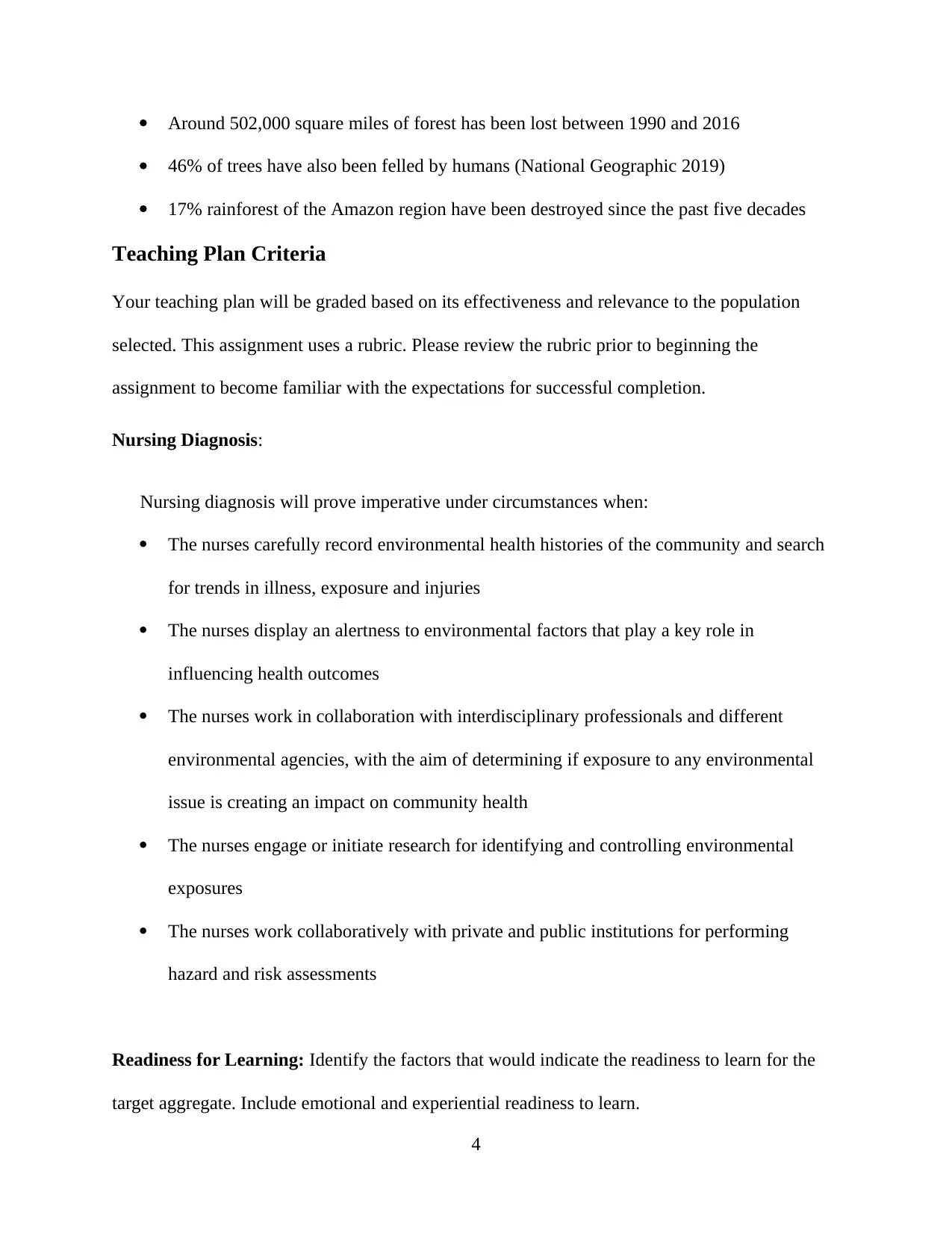
Around 502,000 square miles of forest has been lost between 1990 and 2016
46% of trees have also been felled by humans (National Geographic 2019)
17% rainforest of the Amazon region have been destroyed since the past five decades
Teaching Plan Criteria
Your teaching plan will be graded based on its effectiveness and relevance to the population
selected. This assignment uses a rubric. Please review the rubric prior to beginning the
assignment to become familiar with the expectations for successful completion.
Nursing Diagnosis:
Nursing diagnosis will prove imperative under circumstances when:
The nurses carefully record environmental health histories of the community and search
for trends in illness, exposure and injuries
The nurses display an alertness to environmental factors that play a key role in
influencing health outcomes
The nurses work in collaboration with interdisciplinary professionals and different
environmental agencies, with the aim of determining if exposure to any environmental
issue is creating an impact on community health
The nurses engage or initiate research for identifying and controlling environmental
exposures
The nurses work collaboratively with private and public institutions for performing
hazard and risk assessments
Readiness for Learning: Identify the factors that would indicate the readiness to learn for the
target aggregate. Include emotional and experiential readiness to learn.
4
46% of trees have also been felled by humans (National Geographic 2019)
17% rainforest of the Amazon region have been destroyed since the past five decades
Teaching Plan Criteria
Your teaching plan will be graded based on its effectiveness and relevance to the population
selected. This assignment uses a rubric. Please review the rubric prior to beginning the
assignment to become familiar with the expectations for successful completion.
Nursing Diagnosis:
Nursing diagnosis will prove imperative under circumstances when:
The nurses carefully record environmental health histories of the community and search
for trends in illness, exposure and injuries
The nurses display an alertness to environmental factors that play a key role in
influencing health outcomes
The nurses work in collaboration with interdisciplinary professionals and different
environmental agencies, with the aim of determining if exposure to any environmental
issue is creating an impact on community health
The nurses engage or initiate research for identifying and controlling environmental
exposures
The nurses work collaboratively with private and public institutions for performing
hazard and risk assessments
Readiness for Learning: Identify the factors that would indicate the readiness to learn for the
target aggregate. Include emotional and experiential readiness to learn.
4
Paraphrase This Document
Need a fresh take? Get an instant paraphrase of this document with our AI Paraphraser
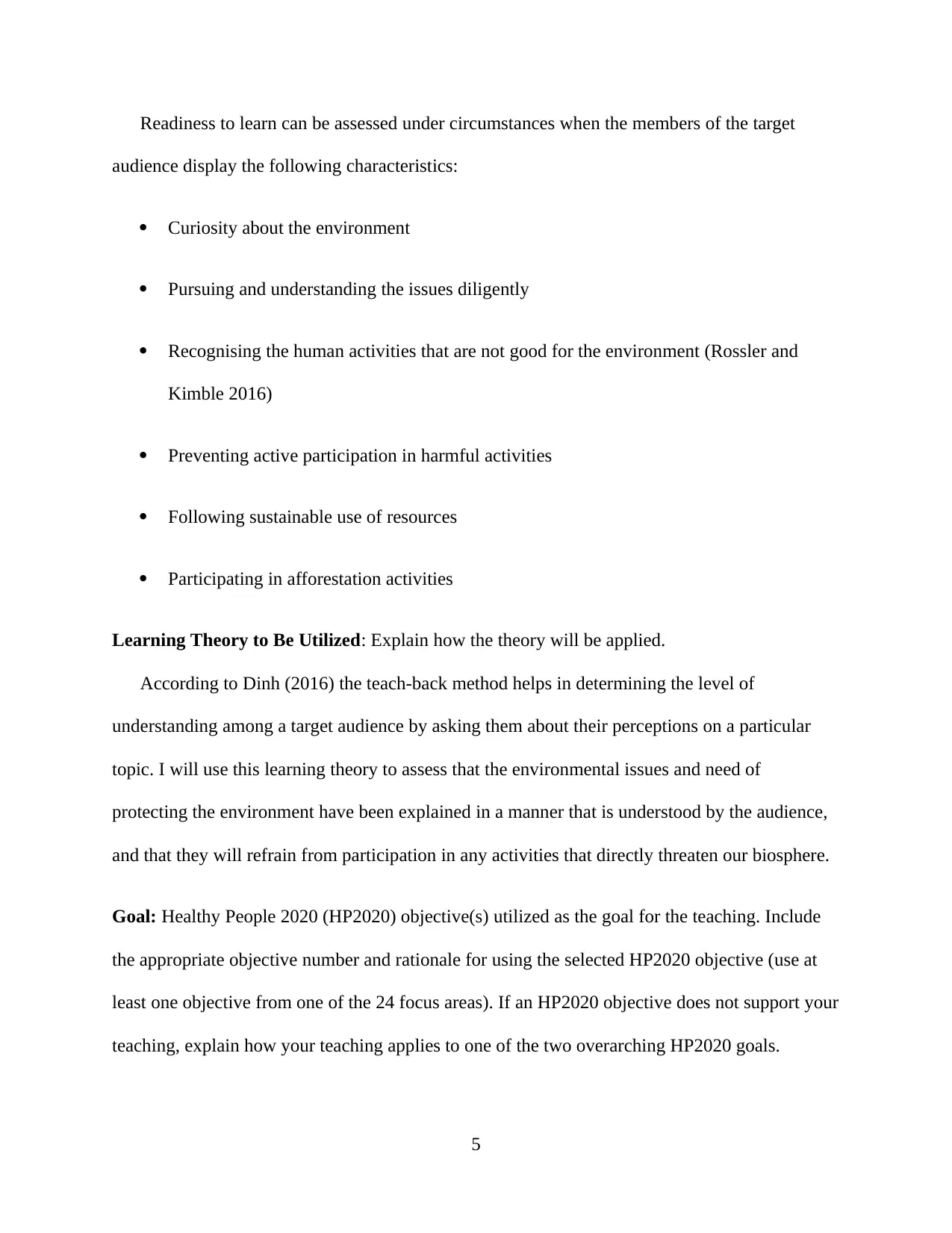
Readiness to learn can be assessed under circumstances when the members of the target
audience display the following characteristics:
Curiosity about the environment
Pursuing and understanding the issues diligently
Recognising the human activities that are not good for the environment (Rossler and
Kimble 2016)
Preventing active participation in harmful activities
Following sustainable use of resources
Participating in afforestation activities
Learning Theory to Be Utilized: Explain how the theory will be applied.
According to Dinh (2016) the teach-back method helps in determining the level of
understanding among a target audience by asking them about their perceptions on a particular
topic. I will use this learning theory to assess that the environmental issues and need of
protecting the environment have been explained in a manner that is understood by the audience,
and that they will refrain from participation in any activities that directly threaten our biosphere.
Goal: Healthy People 2020 (HP2020) objective(s) utilized as the goal for the teaching. Include
the appropriate objective number and rationale for using the selected HP2020 objective (use at
least one objective from one of the 24 focus areas). If an HP2020 objective does not support your
teaching, explain how your teaching applies to one of the two overarching HP2020 goals.
5
audience display the following characteristics:
Curiosity about the environment
Pursuing and understanding the issues diligently
Recognising the human activities that are not good for the environment (Rossler and
Kimble 2016)
Preventing active participation in harmful activities
Following sustainable use of resources
Participating in afforestation activities
Learning Theory to Be Utilized: Explain how the theory will be applied.
According to Dinh (2016) the teach-back method helps in determining the level of
understanding among a target audience by asking them about their perceptions on a particular
topic. I will use this learning theory to assess that the environmental issues and need of
protecting the environment have been explained in a manner that is understood by the audience,
and that they will refrain from participation in any activities that directly threaten our biosphere.
Goal: Healthy People 2020 (HP2020) objective(s) utilized as the goal for the teaching. Include
the appropriate objective number and rationale for using the selected HP2020 objective (use at
least one objective from one of the 24 focus areas). If an HP2020 objective does not support your
teaching, explain how your teaching applies to one of the two overarching HP2020 goals.
5
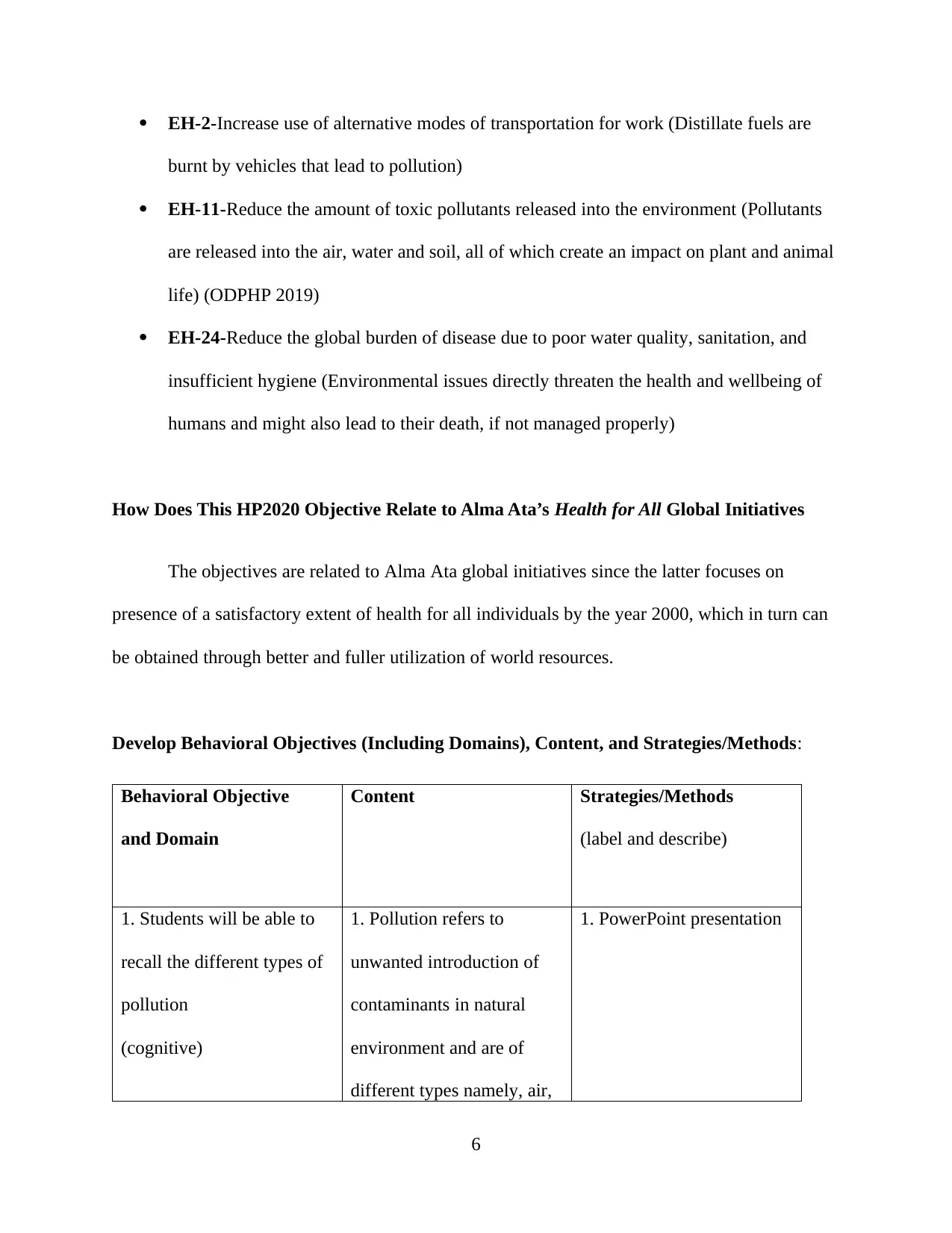
EH-2-Increase use of alternative modes of transportation for work (Distillate fuels are
burnt by vehicles that lead to pollution)
EH-11-Reduce the amount of toxic pollutants released into the environment (Pollutants
are released into the air, water and soil, all of which create an impact on plant and animal
life) (ODPHP 2019)
EH-24-Reduce the global burden of disease due to poor water quality, sanitation, and
insufficient hygiene (Environmental issues directly threaten the health and wellbeing of
humans and might also lead to their death, if not managed properly)
How Does This HP2020 Objective Relate to Alma Ata’s Health for All Global Initiatives
The objectives are related to Alma Ata global initiatives since the latter focuses on
presence of a satisfactory extent of health for all individuals by the year 2000, which in turn can
be obtained through better and fuller utilization of world resources.
Develop Behavioral Objectives (Including Domains), Content, and Strategies/Methods:
Behavioral Objective
and Domain
Content Strategies/Methods
(label and describe)
1. Students will be able to
recall the different types of
pollution
(cognitive)
1. Pollution refers to
unwanted introduction of
contaminants in natural
environment and are of
different types namely, air,
1. PowerPoint presentation
6
burnt by vehicles that lead to pollution)
EH-11-Reduce the amount of toxic pollutants released into the environment (Pollutants
are released into the air, water and soil, all of which create an impact on plant and animal
life) (ODPHP 2019)
EH-24-Reduce the global burden of disease due to poor water quality, sanitation, and
insufficient hygiene (Environmental issues directly threaten the health and wellbeing of
humans and might also lead to their death, if not managed properly)
How Does This HP2020 Objective Relate to Alma Ata’s Health for All Global Initiatives
The objectives are related to Alma Ata global initiatives since the latter focuses on
presence of a satisfactory extent of health for all individuals by the year 2000, which in turn can
be obtained through better and fuller utilization of world resources.
Develop Behavioral Objectives (Including Domains), Content, and Strategies/Methods:
Behavioral Objective
and Domain
Content Strategies/Methods
(label and describe)
1. Students will be able to
recall the different types of
pollution
(cognitive)
1. Pollution refers to
unwanted introduction of
contaminants in natural
environment and are of
different types namely, air,
1. PowerPoint presentation
6
⊘ This is a preview!⊘
Do you want full access?
Subscribe today to unlock all pages.

Trusted by 1+ million students worldwide
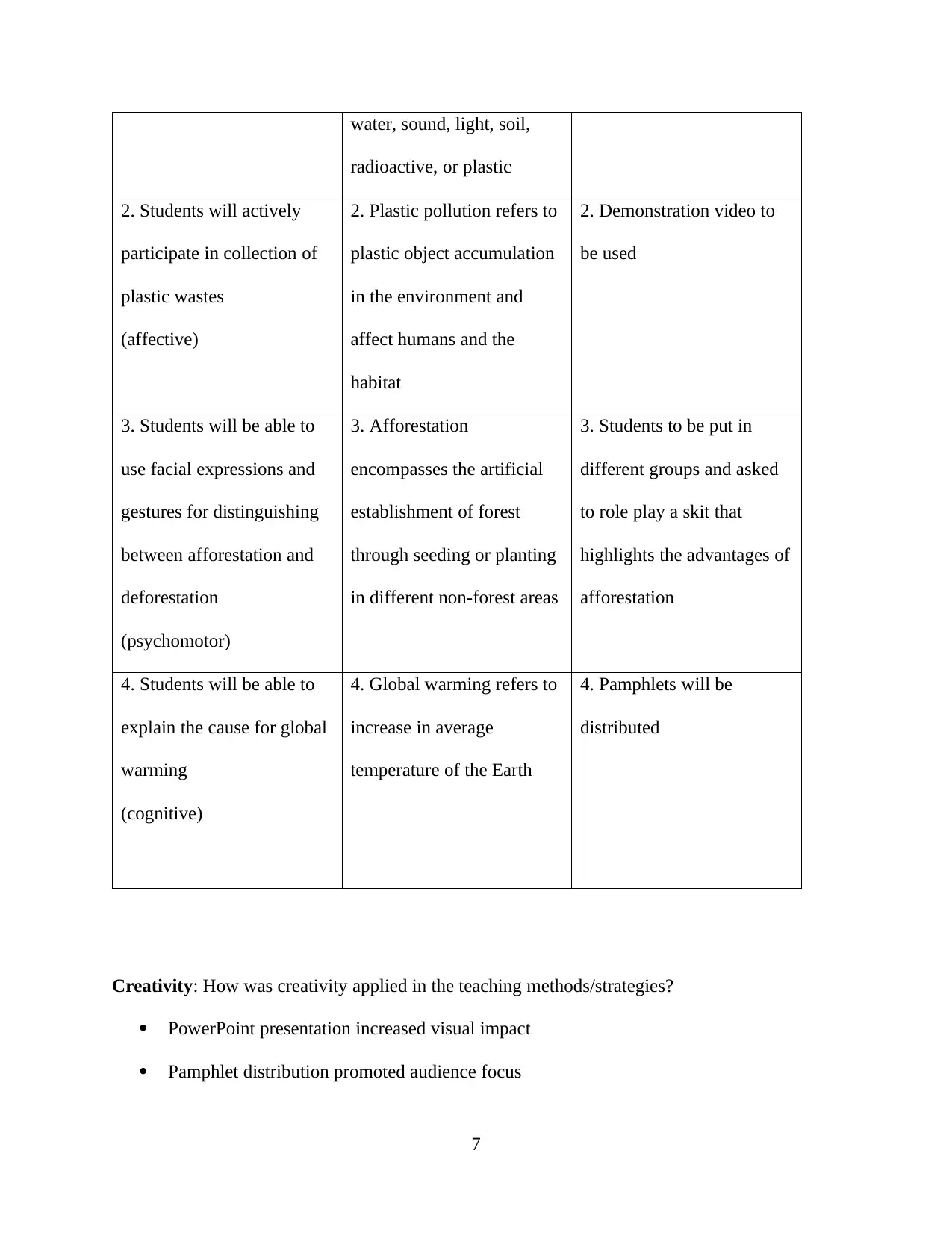
water, sound, light, soil,
radioactive, or plastic
2. Students will actively
participate in collection of
plastic wastes
(affective)
2. Plastic pollution refers to
plastic object accumulation
in the environment and
affect humans and the
habitat
2. Demonstration video to
be used
3. Students will be able to
use facial expressions and
gestures for distinguishing
between afforestation and
deforestation
(psychomotor)
3. Afforestation
encompasses the artificial
establishment of forest
through seeding or planting
in different non-forest areas
3. Students to be put in
different groups and asked
to role play a skit that
highlights the advantages of
afforestation
4. Students will be able to
explain the cause for global
warming
(cognitive)
4. Global warming refers to
increase in average
temperature of the Earth
4. Pamphlets will be
distributed
Creativity: How was creativity applied in the teaching methods/strategies?
PowerPoint presentation increased visual impact
Pamphlet distribution promoted audience focus
7
radioactive, or plastic
2. Students will actively
participate in collection of
plastic wastes
(affective)
2. Plastic pollution refers to
plastic object accumulation
in the environment and
affect humans and the
habitat
2. Demonstration video to
be used
3. Students will be able to
use facial expressions and
gestures for distinguishing
between afforestation and
deforestation
(psychomotor)
3. Afforestation
encompasses the artificial
establishment of forest
through seeding or planting
in different non-forest areas
3. Students to be put in
different groups and asked
to role play a skit that
highlights the advantages of
afforestation
4. Students will be able to
explain the cause for global
warming
(cognitive)
4. Global warming refers to
increase in average
temperature of the Earth
4. Pamphlets will be
distributed
Creativity: How was creativity applied in the teaching methods/strategies?
PowerPoint presentation increased visual impact
Pamphlet distribution promoted audience focus
7
Paraphrase This Document
Need a fresh take? Get an instant paraphrase of this document with our AI Paraphraser
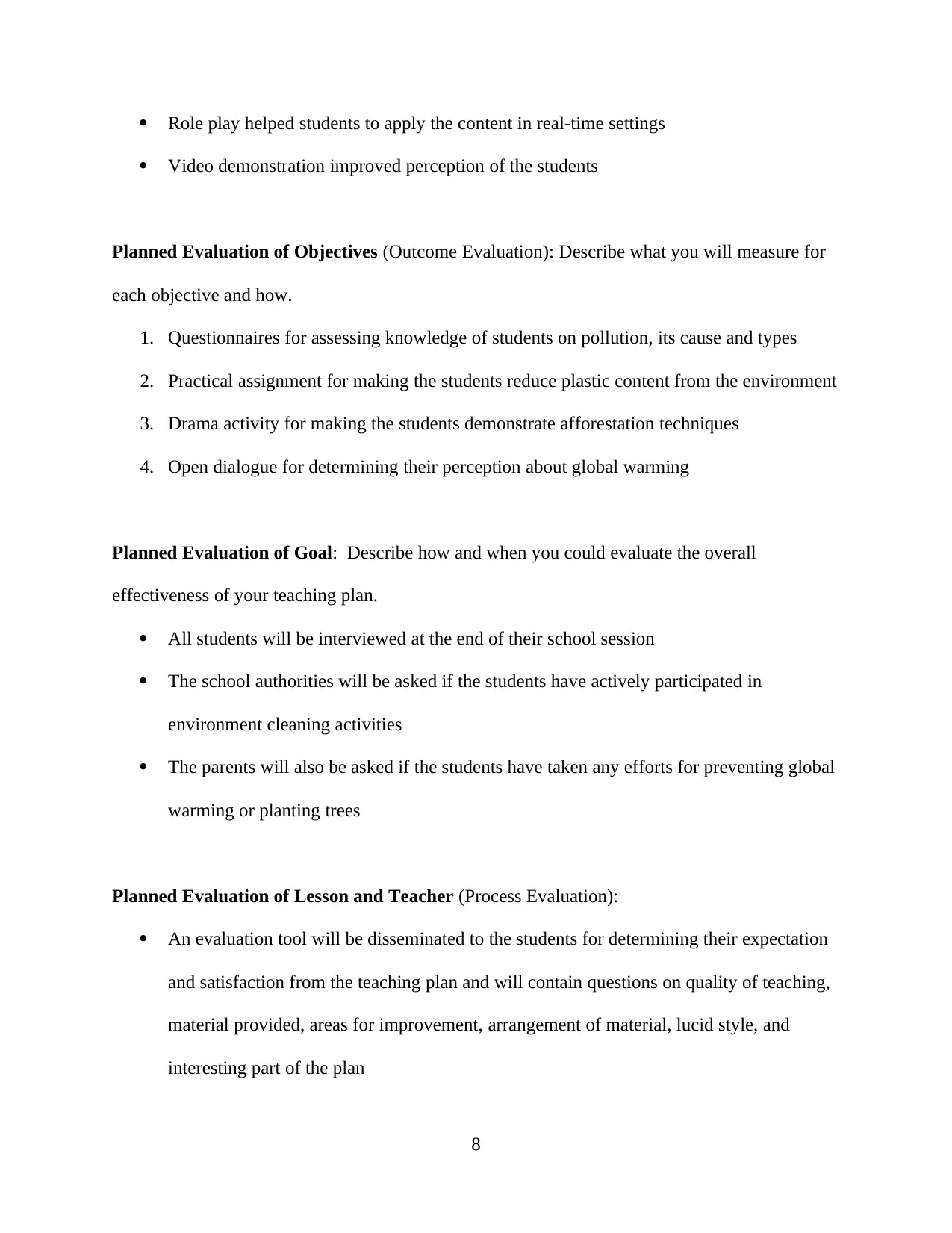
Role play helped students to apply the content in real-time settings
Video demonstration improved perception of the students
Planned Evaluation of Objectives (Outcome Evaluation): Describe what you will measure for
each objective and how.
1. Questionnaires for assessing knowledge of students on pollution, its cause and types
2. Practical assignment for making the students reduce plastic content from the environment
3. Drama activity for making the students demonstrate afforestation techniques
4. Open dialogue for determining their perception about global warming
Planned Evaluation of Goal: Describe how and when you could evaluate the overall
effectiveness of your teaching plan.
All students will be interviewed at the end of their school session
The school authorities will be asked if the students have actively participated in
environment cleaning activities
The parents will also be asked if the students have taken any efforts for preventing global
warming or planting trees
Planned Evaluation of Lesson and Teacher (Process Evaluation):
An evaluation tool will be disseminated to the students for determining their expectation
and satisfaction from the teaching plan and will contain questions on quality of teaching,
material provided, areas for improvement, arrangement of material, lucid style, and
interesting part of the plan
8
Video demonstration improved perception of the students
Planned Evaluation of Objectives (Outcome Evaluation): Describe what you will measure for
each objective and how.
1. Questionnaires for assessing knowledge of students on pollution, its cause and types
2. Practical assignment for making the students reduce plastic content from the environment
3. Drama activity for making the students demonstrate afforestation techniques
4. Open dialogue for determining their perception about global warming
Planned Evaluation of Goal: Describe how and when you could evaluate the overall
effectiveness of your teaching plan.
All students will be interviewed at the end of their school session
The school authorities will be asked if the students have actively participated in
environment cleaning activities
The parents will also be asked if the students have taken any efforts for preventing global
warming or planting trees
Planned Evaluation of Lesson and Teacher (Process Evaluation):
An evaluation tool will be disseminated to the students for determining their expectation
and satisfaction from the teaching plan and will contain questions on quality of teaching,
material provided, areas for improvement, arrangement of material, lucid style, and
interesting part of the plan
8
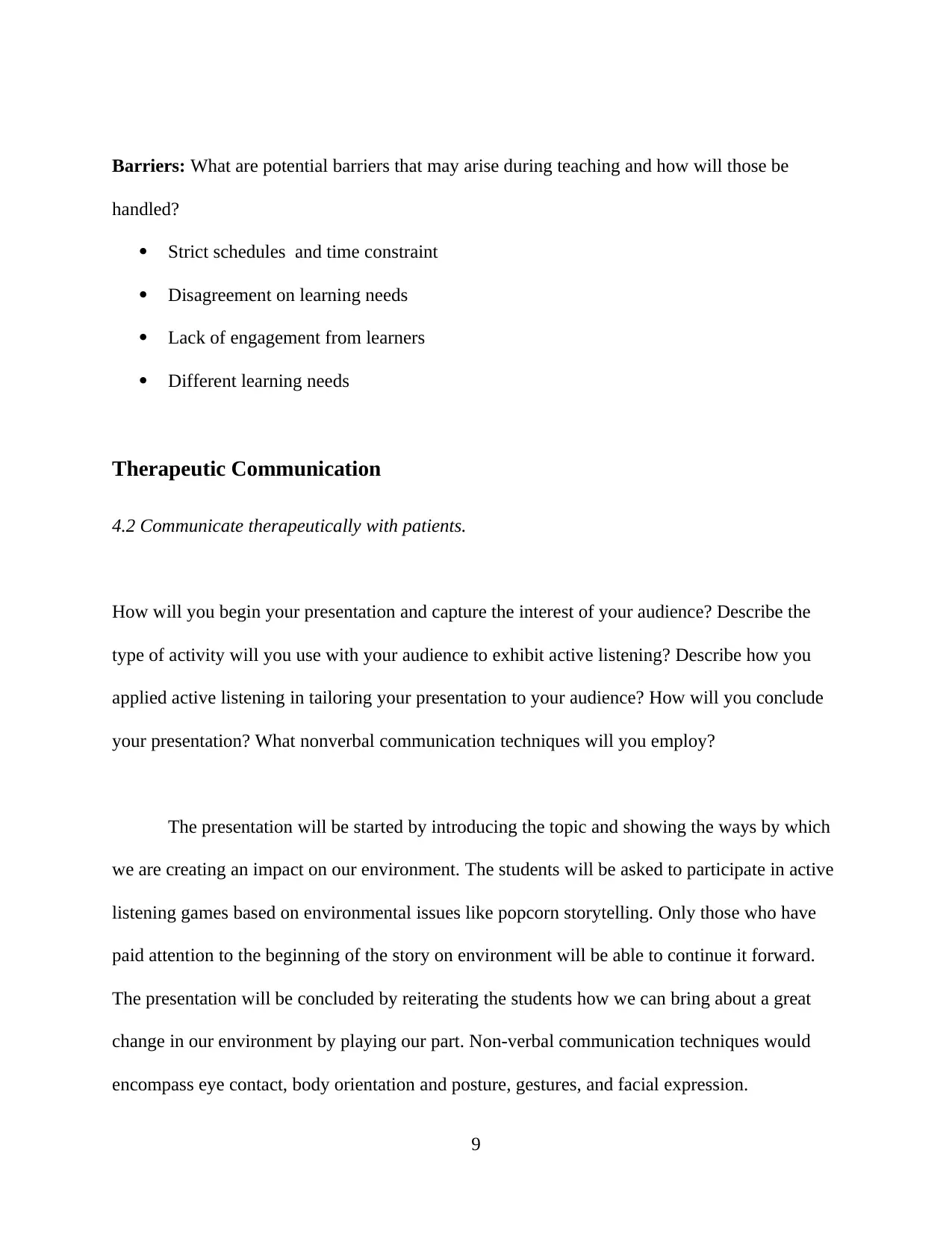
Barriers: What are potential barriers that may arise during teaching and how will those be
handled?
Strict schedules and time constraint
Disagreement on learning needs
Lack of engagement from learners
Different learning needs
Therapeutic Communication
4.2 Communicate therapeutically with patients.
How will you begin your presentation and capture the interest of your audience? Describe the
type of activity will you use with your audience to exhibit active listening? Describe how you
applied active listening in tailoring your presentation to your audience? How will you conclude
your presentation? What nonverbal communication techniques will you employ?
The presentation will be started by introducing the topic and showing the ways by which
we are creating an impact on our environment. The students will be asked to participate in active
listening games based on environmental issues like popcorn storytelling. Only those who have
paid attention to the beginning of the story on environment will be able to continue it forward.
The presentation will be concluded by reiterating the students how we can bring about a great
change in our environment by playing our part. Non-verbal communication techniques would
encompass eye contact, body orientation and posture, gestures, and facial expression.
9
handled?
Strict schedules and time constraint
Disagreement on learning needs
Lack of engagement from learners
Different learning needs
Therapeutic Communication
4.2 Communicate therapeutically with patients.
How will you begin your presentation and capture the interest of your audience? Describe the
type of activity will you use with your audience to exhibit active listening? Describe how you
applied active listening in tailoring your presentation to your audience? How will you conclude
your presentation? What nonverbal communication techniques will you employ?
The presentation will be started by introducing the topic and showing the ways by which
we are creating an impact on our environment. The students will be asked to participate in active
listening games based on environmental issues like popcorn storytelling. Only those who have
paid attention to the beginning of the story on environment will be able to continue it forward.
The presentation will be concluded by reiterating the students how we can bring about a great
change in our environment by playing our part. Non-verbal communication techniques would
encompass eye contact, body orientation and posture, gestures, and facial expression.
9
⊘ This is a preview!⊘
Do you want full access?
Subscribe today to unlock all pages.

Trusted by 1+ million students worldwide

10
Paraphrase This Document
Need a fresh take? Get an instant paraphrase of this document with our AI Paraphraser
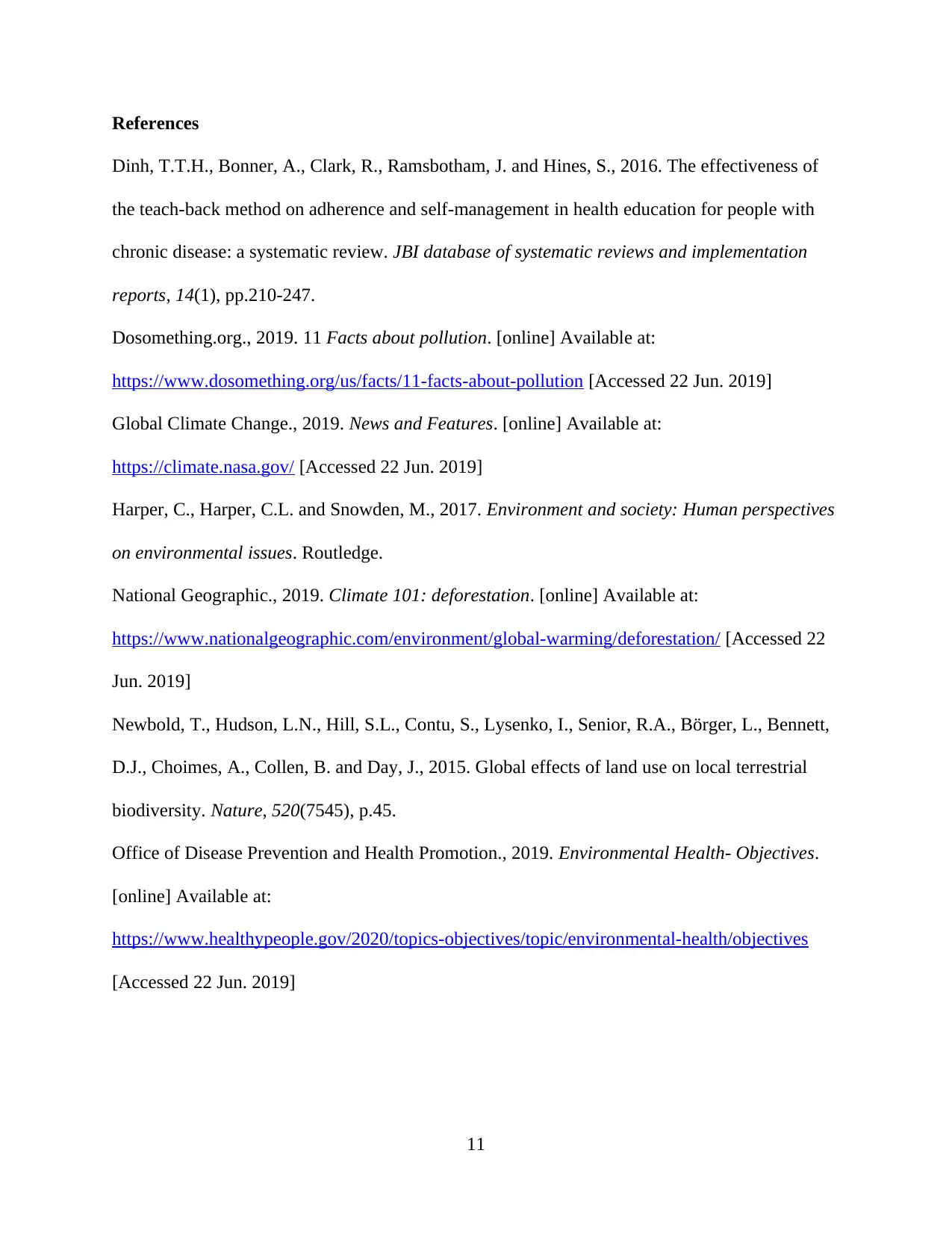
References
Dinh, T.T.H., Bonner, A., Clark, R., Ramsbotham, J. and Hines, S., 2016. The effectiveness of
the teach-back method on adherence and self-management in health education for people with
chronic disease: a systematic review. JBI database of systematic reviews and implementation
reports, 14(1), pp.210-247.
Dosomething.org., 2019. 11 Facts about pollution. [online] Available at:
https://www.dosomething.org/us/facts/11-facts-about-pollution [Accessed 22 Jun. 2019]
Global Climate Change., 2019. News and Features. [online] Available at:
https://climate.nasa.gov/ [Accessed 22 Jun. 2019]
Harper, C., Harper, C.L. and Snowden, M., 2017. Environment and society: Human perspectives
on environmental issues. Routledge.
National Geographic., 2019. Climate 101: deforestation. [online] Available at:
https://www.nationalgeographic.com/environment/global-warming/deforestation/ [Accessed 22
Jun. 2019]
Newbold, T., Hudson, L.N., Hill, S.L., Contu, S., Lysenko, I., Senior, R.A., Börger, L., Bennett,
D.J., Choimes, A., Collen, B. and Day, J., 2015. Global effects of land use on local terrestrial
biodiversity. Nature, 520(7545), p.45.
Office of Disease Prevention and Health Promotion., 2019. Environmental Health- Objectives.
[online] Available at:
https://www.healthypeople.gov/2020/topics-objectives/topic/environmental-health/objectives
[Accessed 22 Jun. 2019]
11
Dinh, T.T.H., Bonner, A., Clark, R., Ramsbotham, J. and Hines, S., 2016. The effectiveness of
the teach-back method on adherence and self-management in health education for people with
chronic disease: a systematic review. JBI database of systematic reviews and implementation
reports, 14(1), pp.210-247.
Dosomething.org., 2019. 11 Facts about pollution. [online] Available at:
https://www.dosomething.org/us/facts/11-facts-about-pollution [Accessed 22 Jun. 2019]
Global Climate Change., 2019. News and Features. [online] Available at:
https://climate.nasa.gov/ [Accessed 22 Jun. 2019]
Harper, C., Harper, C.L. and Snowden, M., 2017. Environment and society: Human perspectives
on environmental issues. Routledge.
National Geographic., 2019. Climate 101: deforestation. [online] Available at:
https://www.nationalgeographic.com/environment/global-warming/deforestation/ [Accessed 22
Jun. 2019]
Newbold, T., Hudson, L.N., Hill, S.L., Contu, S., Lysenko, I., Senior, R.A., Börger, L., Bennett,
D.J., Choimes, A., Collen, B. and Day, J., 2015. Global effects of land use on local terrestrial
biodiversity. Nature, 520(7545), p.45.
Office of Disease Prevention and Health Promotion., 2019. Environmental Health- Objectives.
[online] Available at:
https://www.healthypeople.gov/2020/topics-objectives/topic/environmental-health/objectives
[Accessed 22 Jun. 2019]
11
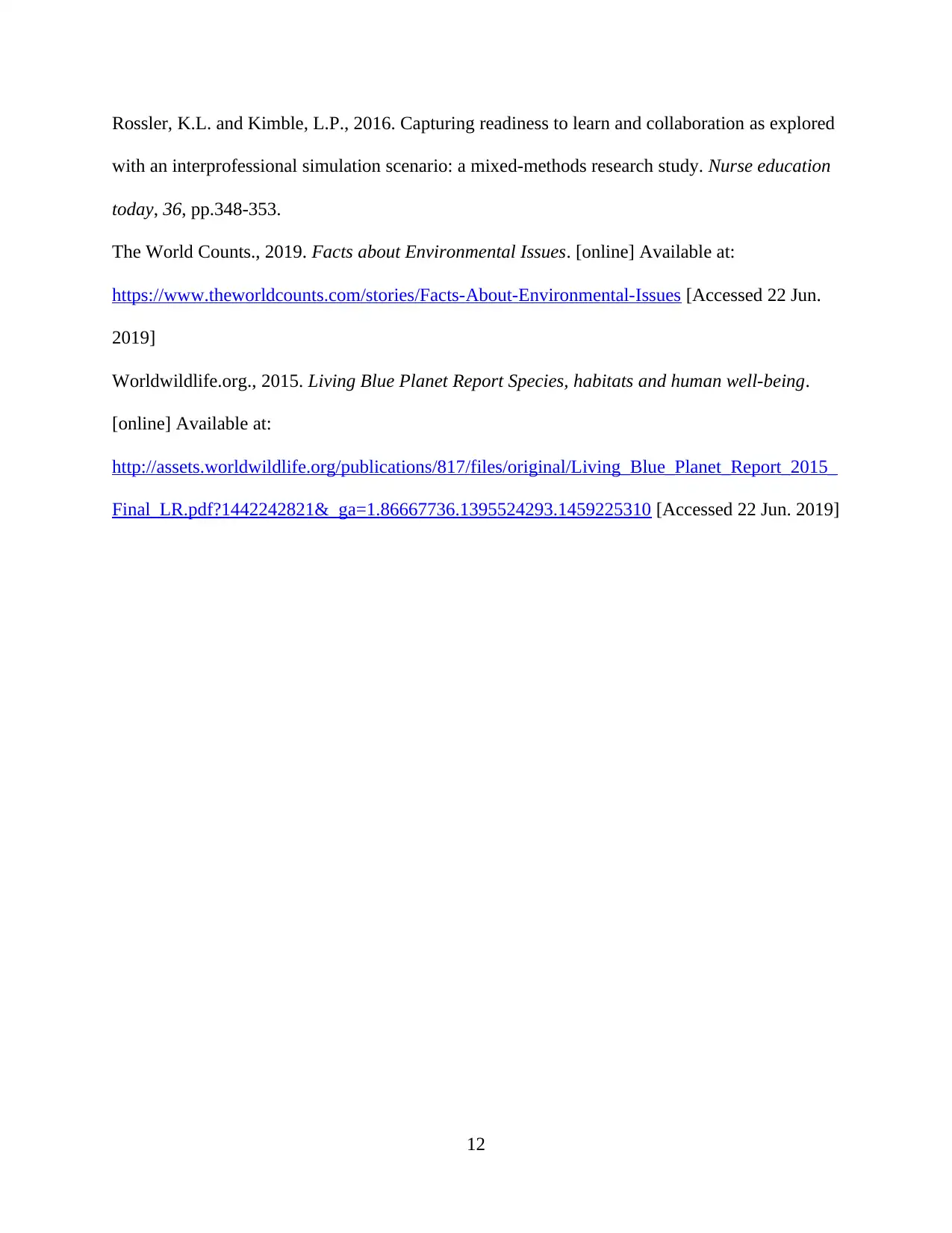
Rossler, K.L. and Kimble, L.P., 2016. Capturing readiness to learn and collaboration as explored
with an interprofessional simulation scenario: a mixed-methods research study. Nurse education
today, 36, pp.348-353.
The World Counts., 2019. Facts about Environmental Issues. [online] Available at:
https://www.theworldcounts.com/stories/Facts-About-Environmental-Issues [Accessed 22 Jun.
2019]
Worldwildlife.org., 2015. Living Blue Planet Report Species, habitats and human well-being.
[online] Available at:
http://assets.worldwildlife.org/publications/817/files/original/Living_Blue_Planet_Report_2015_
Final_LR.pdf?1442242821&_ga=1.86667736.1395524293.1459225310 [Accessed 22 Jun. 2019]
12
with an interprofessional simulation scenario: a mixed-methods research study. Nurse education
today, 36, pp.348-353.
The World Counts., 2019. Facts about Environmental Issues. [online] Available at:
https://www.theworldcounts.com/stories/Facts-About-Environmental-Issues [Accessed 22 Jun.
2019]
Worldwildlife.org., 2015. Living Blue Planet Report Species, habitats and human well-being.
[online] Available at:
http://assets.worldwildlife.org/publications/817/files/original/Living_Blue_Planet_Report_2015_
Final_LR.pdf?1442242821&_ga=1.86667736.1395524293.1459225310 [Accessed 22 Jun. 2019]
12
⊘ This is a preview!⊘
Do you want full access?
Subscribe today to unlock all pages.

Trusted by 1+ million students worldwide
1 out of 12
Related Documents
Your All-in-One AI-Powered Toolkit for Academic Success.
+13062052269
info@desklib.com
Available 24*7 on WhatsApp / Email
![[object Object]](/_next/static/media/star-bottom.7253800d.svg)
Unlock your academic potential
Copyright © 2020–2025 A2Z Services. All Rights Reserved. Developed and managed by ZUCOL.




